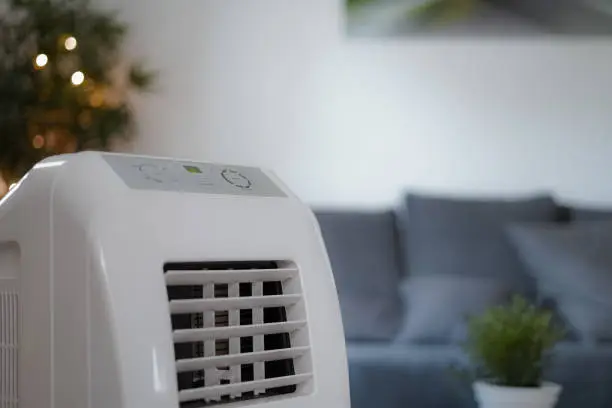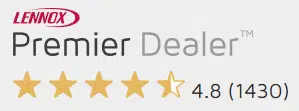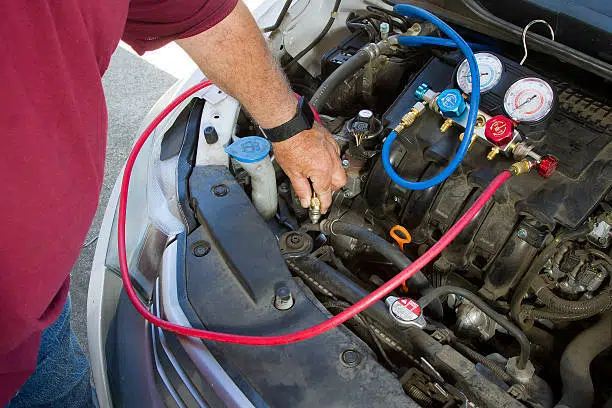
Table of Contents
While traditional central air conditioning systems are common, their installation and maintenance costs can be prohibitive, especially for renters or those living in smaller spaces. This is where portable air conditioners come into play. Portable AC units have gained popularity due to their flexibility and ease of use, offering a convenient solution for cooling specific areas without the need for permanent installation.
Basic Components of a Portable Air Conditioner
At the heart of every portable air conditioner are several key components working together to provide effective cooling. Understanding these components is crucial to grasp how portable air conditioners operate.
A portable air conditioner typically consists of a compressor, condenser, evaporator, refrigerant, and exhaust hose. The compressor plays a vital role in pressurizing the refrigerant, transforming it into a high-pressure gas. This gas then moves to the condenser, where it releases heat and condenses into a high-pressure liquid. The liquid refrigerant then travels to the evaporator, where it expands and evaporates, absorbing heat from the surrounding air. Finally, the cool air is circulated back into the room, while the warm refrigerant gas returns to the compressor to begin the cycle anew.
Check out the cost of a new air conditioner installation in Canada in our previous guide.
https://thehvacservice.ca/what-is-the-cost-of-air-conditioning-installation/
How Does the Cooling Process of Portable Air Conditioners Work?
The cooling process in portable air conditioners follows a systematic cycle to extract heat from indoor air and expel it outside. Let’s dive into the process of portable air conditioners work.
- Compression of Refrigerant: When activated, the compressor in a portable air conditioner begins the cooling process by compressing the refrigerant gas. This action significantly increases both its pressure and temperature.
- Heat Release in the Condenser: Following compression, the high-pressure, high-temperature refrigerant gas moves into the condenser unit, typically located on the back or side of the portable AC. Here, the gas releases heat into the surrounding environment and condenses into a high-pressure liquid.
- Phase Change in the Evaporator: The liquid refrigerant then travels to the evaporator, situated inside the portable air conditioner. Within the evaporator, the high-pressure liquid undergoes a phase change, transitioning into a low-pressure gas. This phase change process results in the absorption of heat from the indoor air, significantly cooling it down.
- Cool Air Circulation: Once cooled, the air is propelled back into the room through the vents or louvers of the portable air conditioner. This circulation of cool air helps maintain a comfortable indoor environment for occupants.
- Return to the Compressor: After absorbing heat from the indoor air, the refrigerant gas returns to the compressor to begin the cycle anew. The compressor then compresses the gas once more, restarting the circulation of refrigerant through the system.
- Exhaust of Hot Air: As the portable air conditioner extracts heat from indoor air, it generates hot air as a byproduct. This hot air is expelled outside the room through the exhaust hose, ensuring that the indoor environment remains balanced and comfortable.
Throughout this process, the portable air conditioner effectively lowers the indoor temperature while expelling hot air outside through the exhaust hose, ensuring a balanced climate indoors.
Ventilation and Exhaust

Proper ventilation is essential for the efficient operation of portable air conditioners. Most portable AC units come equipped with an exhaust hose, which serves to expel hot air generated during the cooling process. It’s crucial to position the exhaust hose correctly to ensure optimal performance.
When setting up a portable air conditioner, place the exhaust hose near a window or another opening to allow the hot air to escape outdoors. Avoid obstructing the exhaust hose or placing it in a cramped space, as this can impede airflow and reduce cooling efficiency. Regularly check the hose for any kinks or blockages to maintain smooth airflow.
Portability and Installation
In the realm of cooling solutions, portable air conditioners stand out for their remarkable mobility and straightforward installation process. Unlike their traditional HVAC counterparts, which often necessitate professional installation due to intricate ductwork, portable AC units offer a hassle-free setup that can be completed swiftly by users of all skill levels.
- When considering the purchase of a portable air conditioner, several factors merit careful deliberation:
- Room size
- Cooling capacity
- Portability features
- Opting for a model equipped with caster wheels ensures effortless maneuverability, allowing users to transport the unit from one room to another with ease.
- Additionally, selecting a compact design ensures that the unit seamlessly integrates into your space without occupying excessive floor area.
While the simplicity of installation is a notable advantage of portable air conditioners, it’s crucial to emphasize the importance of proper setup to maximize performance and longevity. Although professional installation may not be required, ensuring that the exhaust hose is securely positioned and that the unit is adequately plugged into a power outlet is essential. By adhering to these basic installation guidelines, users can enjoy the cooling benefits of their portable air conditioner with confidence.
At HVAC Service Solutions, we understand the significance of a seamless installation process and are committed to assisting our customers every step of the way. Our team of experienced professionals is available to provide expert guidance on selecting the right portable air conditioner for your needs and ensuring proper installation to optimize performance.
Energy Efficiency and Cost Savings with Portable Air Conditioners
Portable air conditioners are renowned for their energy efficiency, offering substantial cost savings for consumers. It’s imperative to prioritize energy efficiency when selecting a portable AC unit, as it directly impacts long-term operating costs. The Energy Efficiency Ratio (EER) serves as a crucial indicator of a unit’s efficiency, representing the ratio of cooling capacity (in British Thermal Units or BTUs) to power input (in watts). A higher EER signifies greater energy efficiency, translating to lower electricity bills.
Energy Efficiency Ratio (EER) for Portable Air Conditioners
Maintenance and Care
Like any appliance, portable air conditioners require regular maintenance to ensure optimal performance and longevity. Start by cleaning or replacing the air filters every few weeks to prevent dust and debris from clogging the unit and hindering airflow. Additionally, check the exhaust hose for any obstructions and ensure it remains securely connected to the unit and the window opening.
Periodically inspect the portable air conditioner for signs of leaks or damage, such as water pooling around the base or unusual noises during operation. If you notice any issues, consult the manufacturer’s instructions or seek professional assistance to address them promptly. By staying proactive with maintenance and care, you can extend the lifespan of your portable air conditioner and enjoy reliable cooling for years to come.
Professional maintenance AC services by HVAC Service Solutions are available to help you with any maintenance needs, ensuring your portable air conditioner operates efficiently and reliably for years to come.
Conclusion
In conclusion, portable air conditioners offer a convenient and efficient solution for cooling specific spaces, providing you with flexibility and ease of installation. Understanding the basic components and operating principles of portable AC units empowers you to make informed decisions when selecting and maintaining these devices. To ensure optimal performance and longevity, regular maintenance and care are essential.
Contact HVAC Service Solutions today for expert advice, professional installation, and reliable maintenance services to keep your portable air conditioner running smoothly for years to come. Stay cool and comfortable with HVAC Service Solutions by your side.
Frequent Asked Questions
How do portable air conditioners differ from traditional HVAC systems?
Portable air conditioners are standalone units designed to cool specific areas or rooms, providing localized cooling solutions. Unlike traditional HVAC systems, which are centralized and cool entire buildings, portable AC units offer flexibility and mobility. Traditional HVAC systems typically consist of an outdoor unit connected to ductwork throughout the building, whereas portable AC units require no permanent installation and can be easily moved from room to room. This makes portable air conditioners ideal for renters, small spaces, or areas where installing a traditional HVAC system is impractical.
What factors should I consider when choosing the right size portable air conditioner for my space?
Selecting the correct size portable air conditioner is essential for optimal performance and energy efficiency. Several factors influence the unit’s cooling capacity and efficiency, including the size of the room, ceiling height, insulation quality, number and size of windows and doors, heat-generating appliances, and even the number of occupants. While a rule of thumb estimates around 20 BTUs per square foot of living space, a professional load calculation considers all these variables to ensure accurate sizing. This ensures that the unit can effectively cool the space without excessive energy consumption or strain on the components.
Can I use a portable air conditioner in a room without windows?
While most portable air conditioners require window venting to expel hot air, alternative venting options are available for rooms without windows. These options may include venting through a sliding door, drop ceiling, or wall vent. However, it’s crucial to ensure proper ventilation to maintain optimal performance and prevent overheating. Some models may also come with a self-evaporative system that recycles condensed moisture to cool the condenser coils, reducing the need for external venting.
What are the advantages of portable air conditioners compared to window units?
Portable air conditioners offer several advantages over window units, making them a popular choice for many consumers. Unlike window units that require permanent installation and may obstruct natural light, portable AC units can be easily moved from room to room and do not require any structural modifications to the building. This makes them ideal for renters or for use in spaces where window installation is not feasible, such as casement or crank windows. Additionally, portable air conditioners typically offer more advanced features and options, such as programmable thermostats, remote controls, and multiple fan speeds, providing greater flexibility and customization for users.
How often should I clean or replace the filters in my portable air conditioner?
Proper maintenance of filters is essential for the efficient operation of a portable air conditioner. The frequency of filter cleaning or replacement depends on usage and environmental conditions. In general, it’s recommended to clean or replace the filters every two to four weeks to ensure optimal performance. Dirty filters can restrict airflow, reduce cooling efficiency, and strain the unit’s components, leading to increased energy consumption and potential damage. Regular maintenance of filters ensures that the unit operates efficiently and extends its lifespan.
Are there any safety precautions I should follow when using a portable air conditioner?
Yes, several safety precautions should be followed when using a portable air conditioner to prevent accidents and ensure proper operation. Firstly, ensure that the unit is placed on a stable surface and away from flammable materials. Adequate ventilation for exhaust air is crucial to prevent overheating, so avoid obstructing the airflow around the unit. Additionally, avoid overloading electrical circuits and regularly inspect the unit for signs of damage or wear. It’s also essential to follow manufacturer instructions for safe usage and maintenance, including proper installation and ventilation requirements.
Can I use a portable air conditioner in conjunction with a central HVAC system?
Yes, portable air conditioners can supplement central HVAC systems to provide additional cooling in specific areas or rooms. This can be particularly beneficial in homes with uneven cooling distribution or areas where the central system may not adequately reach. However, it’s essential to ensure proper sizing and placement of the portable unit for optimal effectiveness and energy efficiency. It’s also crucial to coordinate the operation of both systems to avoid overcooling or conflicting temperature settings.
How do I properly vent a portable air conditioner?
Proper ventilation is crucial for the efficient operation of a portable air conditioner. Most units come with an exhaust hose that needs to be vented through a window or another opening to expel hot air outside. It’s important to ensure that the exhaust hose is securely connected and free from obstructions to maintain optimal airflow and cooling performance. Some models may also include a window venting kit or adjustable window bracket for easy installation and secure venting.
Are there any energy-saving tips for operating a portable air conditioner?
Yes, several energy-saving tips can help maximize the efficiency of a portable air conditioner and reduce operating costs. Firstly, consider setting the thermostat to a higher temperature when you’re not at home or using a room to reduce unnecessary cooling. Use programmable timers or smart thermostats to regulate cooling based on your schedule and avoid running the unit continuously. Additionally, ensure proper insulation and seal any gaps around windows and doors to prevent air leakage, allowing the unit to maintain a consistent temperature more efficiently.
What maintenance tasks can I perform myself, and when should I seek professional assistance for my portable air conditioner?
While regular maintenance tasks such as cleaning or replacing the air filters, inspecting the exhaust hose for obstructions, and ensuring proper ventilation can typically be performed by homeowners, some issues may require professional assistance. If you notice signs of leaks, unusual noises, or other operational issues, it’s best to seek professional assistance to diagnose and address the problem. HVAC Service Solutions offers comprehensive maintenance services to ensure your portable air conditioner operates efficiently and reliably for years to come. Contact us today for expert assistance with your cooling needs.
Share



















